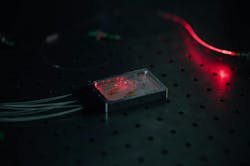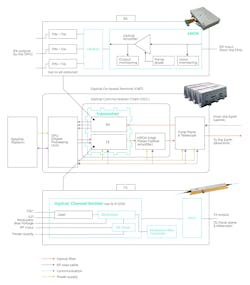Optical transceivers enable complex space optical communications
Developed by Airbus Defense & Space and CNES (French space agency), and hosted aboard the Arabsat Badr-8 satellite 36,000 km above Earth, TELEO features a laser terminal equipped with an optical transceiver assembled and space-qualified by Exail. With a focus on innovation, risk-taking, and customer satisfaction, Exail is empowering photonics engineers worldwide with advanced high-performance solutions designed for a wide variety of environments—from temperature-stabilized laboratories to deep space.
Space-grade optical components and subsystems power complex space missions
The optical transceiver fully integrated by Exail for TELEO consists of a transmitter and a receiver channel built with key subcomponents. These include a low-noise optical amplifier (LNOA), which features radiation-hardened (rad-hard) doped optical fibers manufactured in-house, along with matching electronics, lithium-niobate (LiNbO3) electro-optical modulators, and an RF amplifier. The development, design, and production of these critical building blocks were made possible through the ESA ARTES “FOLC2” project.
The reliability of our LiNbO3-based modulators and space-grade optical fibers stem from the company’s core expertise in fiber-optic gyroscopes, which have accumulated more than 6 million hours of orbit by more than 30 satellites without incident during the past two decades. These TRL9 optical components have also been chosen by the leading space agencies, including NASA, ESA, and JAXA, for high-profile missions such as GRACE FO, GRACE-C, and LISA.
Optical modulators and fibers designed for New Space applications
Exail’s LiNbO3 modulators are designed in engineering model, New Space flight model, and flight model versions, as part of standardized commercial-off-the-shelf (COTS) product lines. These standardized space-grade modulators provide cost-effective solutions with varying levels of customization to meet each customer’s specific requirements. While the New Space flight model (NS-FM) modulators are flight-ready versions based on proven qualification heritage, the high-reliability flight model (FM) modulators are produced from the same fabrication batch and follow a dedicated, relaxed qualification program (or lot acceptance test). This qualification process can be tailored to mission specifications in collaboration with the customer.
Exail’s space-grade optical fibers used in the development of LNOAs and high-power optical amplifiers (HPOAs), for geostationary applications, are rad-hard. We delivered enough rad-hard optical fibers in 2024 to manufacture thousands of LNOAs or HPOAs. These space-grade rad-hard fibers are also available within COTS product lines, with (“RAD” fibers) or without (“NS” fibers) radiation tests.
Optical ground stations
Satellite constellations orbiting Earth to relay communications between different locations form a mesh network that connects to ground stations for data transmission back to Earth. These ground-based stations can be equipped with optical solutions to serve as optical communication links.
We contributed to the optical ground stations involved in TELEO by supplying doped fibers for HPOAs, LNOAs, and transceiver terminals for reception and transmission front-end channels (ModBox OGS).
While space-grade HPOAs for embedded applications typically operate within the 2- to 30-W range, those designed for optical ground stations can reach up to 100 W. This increase in power is achieved using specialty optical fibers—such as erbium/ytterbium-doped large-mode-area fibers or double-clad erbium-doped fibers—designed and manufactured by us through extensive R&D efforts, including collaborations with CNES.
Pioneering space-grade micro-optical assemblies
Among Exail’s cutting-edge solutions for space is the TRL6 Multiplexer/Demultiplexer (MUX/DEMUX), based on free-space micro-optical assemblies. This compact, high-performance solution minimizes subsystem footprint for space applications while ensuring robustness across a wide temperature range. Already deployed in optical ground stations, the MUX/DEMUX is undergoing space qualification until July 2025 as part of the CO-OP project, a French consortium led by CNES which aims to deliver a 100 Gbps space optical link.
We’re also manufacturing free-space optical coherent detectors for both terrestrial and space applications (TRL9), and serve as a space integrator for our partners’ coherent detection solutions to deliver optoelectronic packages that enable efficient demodulation.
Both the MUX/DEMUX and the free-space optical coherent detectors are manufactured using our in-house ultraprecise micro-optics assembly process. To meet the growing demand for space-grade products, we acquired a new hermetic seam-sealing system in 2022 to enable mass production of these components within a controlled atmosphere at atmospheric pressure.
Future operational systems: High-speed telecom and quantum technology
Our collaboration with Airbus represents a major milestone in space deployment of optical technologies. The success of TELEO validates the performance of our TRL9 optical components and paves the way for future operational systems, including high-contrast optoelectronic modulators for high-speed telecommunications and quantum key distribution (QKD) communications in space, and other quantum applications operating in the near-infrared.
Exail’s teams take pride in advancing optical technologies for space applications and look forward to contributing to future projects.
About the Author
Hervé Gouraud
Hervé Gouraud is photonics commercial director at Exail (Saint-Germain en Laye, France).

